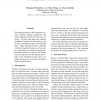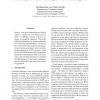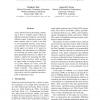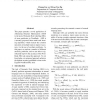ACL
2007
14 years 1 months ago
2007
We study the issue of porting a known NLP method to a language with little existing NLP resources, specifically Hebrew SVM-based chunking. We introduce two SVM-based methods – ...
ACL
2007
14 years 1 months ago
2007
This paper describes a fully automatic twostage machine learning architecture that learns temporal relations between pairs of events. The first stage learns the temporal attribut...
ACL
2007
14 years 1 months ago
2007
Even in a massive corpus such as the Web, a substantial fraction of extractions appear infrequently. This paper shows how to assess the correctness of sparse extractions by utiliz...
ACL
2007
14 years 1 months ago
2007
We present the design and evaluation of a translator’s amenuensis that uses comparable corpora to propose and rank nonliteral solutions to the translation of expressions from th...
ACL
2007
14 years 1 months ago
2007
When a word sense disambiguation (WSD) system is trained on one domain but applied to a different domain, a drop in accuracy is frequently observed. This highlights the importance...
ACL
2007
14 years 1 months ago
2007
A key question facing the parsing community is how to compare parsers which use different grammar formalisms and produce different output. Evaluating a parser on the same resource...
ACL
2007
14 years 1 months ago
2007
In this paper, we propose forest-to-string rules to enhance the expressive power of tree-to-string translation models. A forestto-string rule is capable of capturing nonsyntactic ...
ACL
2007
14 years 1 months ago
2007
In this paper, we propose a novel discriminative language model, which can be applied quite generally. Compared to the well known N-gram language models, discriminative language m...
ACL
2007
14 years 1 months ago
2007
Non-verbal modalities such as gesture can improve processing of spontaneous spoken language. For example, similar hand gestures tend to predict semantic similarity, so features th...
ACL
2007
14 years 1 months ago
2007
This paper presents a novel application of Alternating Structure Optimization (ASO) to the task of Semantic Role Labeling (SRL) of noun predicates in NomBank. ASO is a recently pr...





